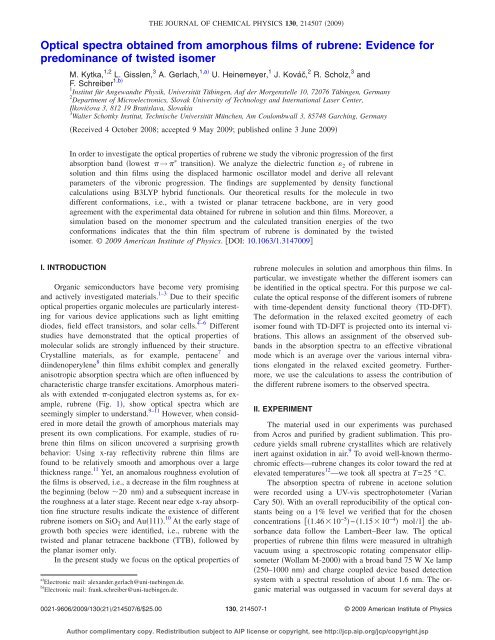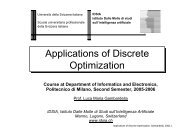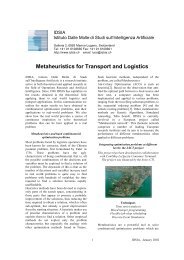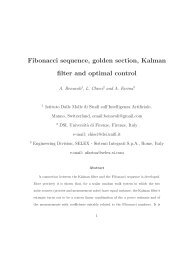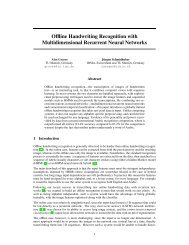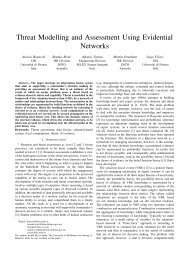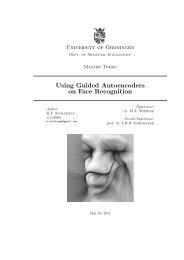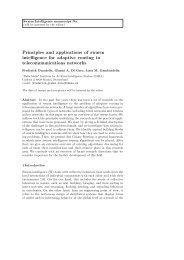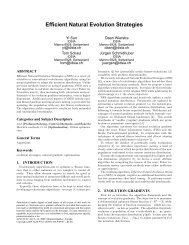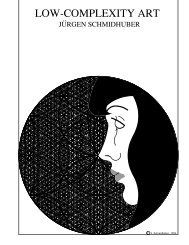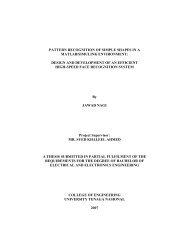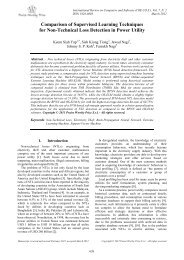Optical spectra obtained from amorphous films of rubrene ... - Idsia
Optical spectra obtained from amorphous films of rubrene ... - Idsia
Optical spectra obtained from amorphous films of rubrene ... - Idsia
You also want an ePaper? Increase the reach of your titles
YUMPU automatically turns print PDFs into web optimized ePapers that Google loves.
<strong>Optical</strong> <strong>spectra</strong> <strong>obtained</strong> <strong>from</strong> <strong>amorphous</strong> <strong>films</strong> <strong>of</strong> <strong>rubrene</strong>: Evidence for<br />
predominance <strong>of</strong> twisted isomer<br />
M. Kytka, 1,2 L. Gisslen, 3 A. Gerlach, 1,a� U. Heinemeyer, 1 J. Kováč, 2 R. Scholz, 3 and<br />
F. Schreiber 1,b�<br />
1 Institut für Angewandte Physik, Universität Tübingen, Auf der Morgenstelle 10, 72076 Tübingen, Germany<br />
2 Department <strong>of</strong> Microelectronics, Slovak University <strong>of</strong> Technology and International Laser Center,<br />
Ilkovičova 3, 812 19 Bratislava, Slovakia<br />
3 Walter Schottky Institut, Technische Universität München, Am Coulombwall 3, 85748 Garching, Germany<br />
�Received 4 October 2008; accepted 9 May 2009; published online 3 June 2009�<br />
In order to investigate the optical properties <strong>of</strong> <strong>rubrene</strong> we study the vibronic progression <strong>of</strong> the first<br />
absorption band �lowest �→� � transition�. We analyze the dielectric function � 2 <strong>of</strong> <strong>rubrene</strong> in<br />
solution and thin <strong>films</strong> using the displaced harmonic oscillator model and derive all relevant<br />
parameters <strong>of</strong> the vibronic progression. The findings are supplemented by density functional<br />
calculations using B3LYP hybrid functionals. Our theoretical results for the molecule in two<br />
different conformations, i.e., with a twisted or planar tetracene backbone, are in very good<br />
agreement with the experimental data <strong>obtained</strong> for <strong>rubrene</strong> in solution and thin <strong>films</strong>. Moreover, a<br />
simulation based on the monomer spectrum and the calculated transition energies <strong>of</strong> the two<br />
conformations indicates that the thin film spectrum <strong>of</strong> <strong>rubrene</strong> is dominated by the twisted<br />
isomer. © 2009 American Institute <strong>of</strong> Physics. �DOI: 10.1063/1.3147009�<br />
I. INTRODUCTION<br />
Organic semiconductors have become very promising<br />
and actively investigated materials. 1–3 Due to their specific<br />
optical properties organic molecules are particularly interesting<br />
for various device applications such as light emitting<br />
diodes, field effect transistors, and solar cells. 4–6 Different<br />
studies have demonstrated that the optical properties <strong>of</strong><br />
molecular solids are strongly influenced by their structure.<br />
Crystalline materials, as for example, pentacene 7 and<br />
diindenoperylene 8 thin <strong>films</strong> exhibit complex and generally<br />
anisotropic absorption <strong>spectra</strong> which are <strong>of</strong>ten influenced by<br />
characteristic charge transfer excitations. Amorphous materials<br />
with extended �-conjugated electron systems as, for example,<br />
<strong>rubrene</strong> �Fig. 1�, show optical <strong>spectra</strong> which are<br />
seemingly simpler to understand. 9–11 However, when considered<br />
in more detail the growth <strong>of</strong> <strong>amorphous</strong> materials may<br />
present its own complications. For example, studies <strong>of</strong> <strong>rubrene</strong><br />
thin <strong>films</strong> on silicon uncovered a surprising growth<br />
behavior: Using x-ray reflectivity <strong>rubrene</strong> thin <strong>films</strong> are<br />
found to be relatively smooth and <strong>amorphous</strong> over a large<br />
thickness range. 11 Yet, an anomalous roughness evolution <strong>of</strong><br />
the <strong>films</strong> is observed, i.e., a decrease in the film roughness at<br />
the beginning �below �20 nm� and a subsequent increase in<br />
the roughness at a later stage. Recent near edge x-ray absorption<br />
fine structure results indicate the existence <strong>of</strong> different<br />
<strong>rubrene</strong> isomers on SiO 2 and Au�111�. 10 At the early stage <strong>of</strong><br />
growth both species were identified, i.e., <strong>rubrene</strong> with the<br />
twisted and planar tetracene backbone �TTB�, followed by<br />
the planar isomer only.<br />
In the present study we focus on the optical properties <strong>of</strong><br />
a� Electronic mail: alexander.gerlach@uni-tuebingen.de.<br />
b� Electronic mail: frank.schreiber@uni-tuebingen.de.<br />
THE JOURNAL OF CHEMICAL PHYSICS 130, 214507 �2009�<br />
<strong>rubrene</strong> molecules in solution and <strong>amorphous</strong> thin <strong>films</strong>. In<br />
particular, we investigate whether the different isomers can<br />
be identified in the optical <strong>spectra</strong>. For this purpose we calculate<br />
the optical response <strong>of</strong> the different isomers <strong>of</strong> <strong>rubrene</strong><br />
with time-dependent density functional theory �TD-DFT�.<br />
The deformation in the relaxed excited geometry <strong>of</strong> each<br />
isomer found with TD-DFT is projected onto its internal vibrations.<br />
This allows an assignment <strong>of</strong> the observed subbands<br />
in the absorption <strong>spectra</strong> to an effective vibrational<br />
mode which is an average over the various internal vibrations<br />
elongated in the relaxed excited geometry. Furthermore,<br />
we use the calculations to assess the contribution <strong>of</strong><br />
the different <strong>rubrene</strong> isomers to the observed <strong>spectra</strong>.<br />
II. EXPERIMENT<br />
The material used in our experiments was purchased<br />
<strong>from</strong> Acros and purified by gradient sublimation. This procedure<br />
yields small <strong>rubrene</strong> crystallites which are relatively<br />
inert against oxidation in air. 9 To avoid well-known thermochromic<br />
effects—<strong>rubrene</strong> changes its color toward the red at<br />
elevated temperatures 12 —we took all <strong>spectra</strong> at T=25 °C.<br />
The absorption <strong>spectra</strong> <strong>of</strong> <strong>rubrene</strong> in acetone solution<br />
were recorded using a UV-vis spectrophotometer �Varian<br />
Cary 50�. With an overall reproducibility <strong>of</strong> the optical constants<br />
being on a 1% level we verified that for the chosen<br />
concentrations ��1.46�10 −5 �−�1.15�10 −4 � mol/l� the absorbance<br />
data follow the Lambert–Beer law. The optical<br />
properties <strong>of</strong> <strong>rubrene</strong> thin <strong>films</strong> were measured in ultrahigh<br />
vacuum using a spectroscopic rotating compensator ellipsometer<br />
�Wollam M-2000� with a broad band 75 W Xe lamp<br />
�250–1000 nm� and charge coupled device based detection<br />
system with a <strong>spectra</strong>l resolution <strong>of</strong> about 1.6 nm. The organic<br />
material was outgassed in vacuum for several days at<br />
0021-9606/2009/130�21�/214507/6/$25.00 130, 214507-1<br />
© 2009 American Institute <strong>of</strong> Physics<br />
Author complimentary copy. Redistribution subject to AIP license or copyright, see http://jcp.aip.org/jcp/copyright.jsp
214507-2 Kytka et al. J. Chem. Phys. 130, 214507 �2009�<br />
FIG. 1. Structure <strong>of</strong> the <strong>rubrene</strong> molecule �C 42H 28� which consists <strong>of</strong> a TTB<br />
and four attached phenyl rings. Due to the different orientations <strong>of</strong> the<br />
phenyl rings and the TTB the �-conjugated systems <strong>of</strong> both parts are nearly<br />
decoupled.<br />
�190 °C in order to remove residual <strong>rubrene</strong> peroxide. 13<br />
Well cleaned Si�100� substrates with a thermal oxide layer<br />
�thickness �20 nm� were transferred into the growth chamber<br />
and kept at temperatures above 400 °C for several hours.<br />
Before deposition <strong>of</strong> the organic material we determined the<br />
thickness <strong>of</strong> the silicon oxide and the precise angle <strong>of</strong> incidence<br />
by ellipsometry. The <strong>rubrene</strong> <strong>films</strong> were deposited at<br />
room temperature via sublimation <strong>from</strong> a Knudsen cell at<br />
210 °C. A typical deposition rate <strong>of</strong> 0.2 nm/min and a pressure<br />
<strong>of</strong> less than 1�10 −9 mbar during growth ensured reproducible<br />
results.<br />
The experimental data were analyzed with the commercial<br />
WVASE32 s<strong>of</strong>tware package. 14 Since <strong>rubrene</strong> grows in<br />
<strong>amorphous</strong> <strong>films</strong>, we used an isotropic model consisting <strong>of</strong><br />
three layers, i.e., <strong>rubrene</strong>—silicon dioxide—silicon, with the<br />
optical constants <strong>of</strong> silicon and silicon dioxide taken <strong>from</strong><br />
Ref. 15. First, we determined the thickness <strong>of</strong> the <strong>rubrene</strong><br />
film by employing a Cauchy model in the <strong>spectra</strong>l range<br />
below 2 eV, where the absorption <strong>of</strong> the organic material is<br />
negligible. Then, we performed a point-by-point fit which<br />
yields the complex dielectric constant � 1+i� 2 for each energy,<br />
see Figs. 2�a� and 2�b�. To check the Kramers–Kronig<br />
consistency <strong>of</strong> the optical constants we also analyzed the<br />
experimental data with a general oscillator model. In this<br />
approach the imaginary part <strong>of</strong> the dielectric function � 2 is<br />
described by a sum <strong>of</strong> Gaussian peaks and the real part � 1 is<br />
derived by the Kramers–Kronig relation. Generally, we<br />
found excellent agreement <strong>of</strong> the results <strong>obtained</strong> either by<br />
point-by-point fits or the general oscillator model. To check<br />
the consistency <strong>of</strong> the results <strong>obtained</strong> by UV-vis spectroscopy<br />
and spectroscopic ellipsometry, we also measured<br />
transmission <strong>spectra</strong> <strong>of</strong> <strong>rubrene</strong> on glass, see Fig. 2�c�. We<br />
found that these data can be described very well using the<br />
optical constants <strong>of</strong> <strong>rubrene</strong> on silicon <strong>obtained</strong> by ellipsometry<br />
�and those <strong>of</strong> glass measured separately with variable<br />
angle ellipsometry�. The minor differences between the data<br />
and the model might be due to oxidation <strong>of</strong> some <strong>rubrene</strong><br />
molecules in air. 16,17<br />
III. RESULTS<br />
A. Analysis <strong>of</strong> the optical <strong>spectra</strong><br />
The imaginary part <strong>of</strong> the dielectric function �Fig. 2�b��<br />
shows a pronounced vibronic progression with five clearly<br />
FIG. 2. �Color online� Complex dielectric function <strong>of</strong> a 33 nm thick <strong>rubrene</strong><br />
film on SiO 2. �a� Real part � 1 and �b� Imaginary part � 2. The optical properties<br />
were <strong>obtained</strong> in situ by spectroscopic ellipsometry and analyzed using<br />
a point-by-point fit. �c� Light transmission through a 34 nm thick <strong>rubrene</strong><br />
film on glass measured in air �solid black�. A model, which is based<br />
on the optical constants <strong>of</strong> <strong>rubrene</strong> shown above �a� and �b� and the optical<br />
constants <strong>of</strong> glass <strong>obtained</strong> separately by variable angle spectroscopic ellipsometry,<br />
can be used to describe the data �dashed red�.<br />
distinguishable subbands. The displaced harmonic oscillator<br />
model—a simplified scheme describing the dipole-allowed<br />
transitions between the electronic ground state �S0� and the<br />
first excited state �S1� including spatial deformations <strong>of</strong> the<br />
molecule �Fig. 3�—has been used to model the data. In this<br />
approximation the excitation energies En are given by<br />
En = E0−0 + nEv, �1�<br />
where E 0−0 is the energy <strong>of</strong> the S 00→S 10 transition, E v is the<br />
vibrational energy, and n is the vibrational quantum number<br />
<strong>of</strong> the excited state. The intensities I n <strong>of</strong> the vibronic subbands<br />
contribute to the imaginary part <strong>of</strong> the dielectric function<br />
according to a Poisson progression<br />
In = I Sn<br />
n! e−S , �2�<br />
where S is the electron-phonon coupling constant, also<br />
known as the Huang–Rhys factor. This coupling parameter<br />
Author complimentary copy. Redistribution subject to AIP license or copyright, see http://jcp.aip.org/jcp/copyright.jsp
214507-3 <strong>Optical</strong> <strong>spectra</strong> <strong>of</strong> <strong>rubrene</strong> J. Chem. Phys. 130, 214507 �2009�<br />
FIG. 3. �Color online� Displaced harmonic oscillator model. Because <strong>of</strong><br />
different electron configurations in the S 0 �HOMO� and the S 1 �LUMO�<br />
electronic excitations result in spatial deformations <strong>of</strong> the molecule. The<br />
corresponding change in the configurational coordinate Q gives rise to the<br />
observed vibronic excitations.<br />
essentially determines the shape <strong>of</strong> the absorption spectrum,<br />
i.e., the relative intensities I n <strong>of</strong> the vibronic subbands, which<br />
are given by the area under each peak.<br />
In order to compare the data taken in solution with the<br />
thin film <strong>spectra</strong>, the absorption coefficient � <strong>of</strong> the solution<br />
has been converted to the dielectric function using the common<br />
approximation that the refractive index is virtually constant<br />
toward high energies and � 2 is then proportional to<br />
�/E. Figure 4�a� shows the normalized data for <strong>rubrene</strong> in<br />
acetone solution and thin <strong>films</strong> together with the corresponding<br />
least-square fits.<br />
With the subband energies given by Eq. �1�, their relative<br />
intensities I n according to the Poisson progression in Eq.<br />
�2�, and a Gaussian for each subband, the imaginary part <strong>of</strong><br />
the dielectric response can be expressed as<br />
5<br />
In � �2� n exp�− �E − En�2 �2�E� = � 2 �, �3�<br />
n=0<br />
2�n where the broadening parameters �n are related to the respective<br />
widths <strong>of</strong> each subband by FWHMn=�8 ln2�n �FWHM denotes full width at half maximum�. Since several<br />
internal modes might contribute to each subband, the linewidths<br />
are not necessarily constant. In the fitting algorithm<br />
all parameters except the width <strong>of</strong> the last two peaks �fixed at<br />
�4=0.08 eV and �5=0.1 eV� have been varied. The<br />
Huang–Rhys factor S is then deduced <strong>from</strong> the intensities <strong>of</strong><br />
the first four transition peaks using Eq. �2�, see Fig. 4�b�. 18<br />
The results <strong>of</strong> the fitting procedure for the vibronic progression<br />
are summarized in Table I.<br />
B. DFT calculations<br />
In order to study the effect <strong>of</strong> possible conformational<br />
changes <strong>of</strong> the molecule and to compare the experimental<br />
results with theory we have computed the excitation energies<br />
and the deformation in the lowest excited state <strong>of</strong> <strong>rubrene</strong><br />
using the TURBOMOLE 5.7 program package. 19 We have chosen<br />
the B3LYP hybrid functional since it gives excellent mo-<br />
FIG. 4. �Color online� �a� Normalized dielectric function � 2 <strong>of</strong>a33nmthick<br />
<strong>rubrene</strong> film �solid black� and <strong>of</strong> a dilute solution <strong>of</strong> <strong>rubrene</strong> in acetone<br />
�solid dark blue� with a fit to the data �dashed red and light blue� based on<br />
Eq. �3�. The absorption spectrum shows a redshift which is caused primarily<br />
by the refractive index <strong>of</strong> the environment �“solvent shift”�. �b� Least-square<br />
fit to the intensities I n <strong>of</strong> the vibronic progression using an interpolation <strong>of</strong><br />
Eq. �2� which yields the Huang–Rhys factors S for the thin film and the<br />
monomer. �c� The width �FWHM� <strong>of</strong> the transitions peaks. In case <strong>of</strong> the<br />
solution it shows a monotonic increase, which indicates that several vibrational<br />
modes contribute to each subband.<br />
TABLE I. Parameters derived <strong>from</strong> the experimental data using the model<br />
<strong>of</strong> the displaced harmonic oscillator for <strong>rubrene</strong> in acetone solution and thin<br />
<strong>films</strong>: Transition energy between the vibrational ground states E 0−0 �eV�,<br />
vibrational energy E v �eV�, and Huang–Rhys factor S.<br />
E 0−0 E v S<br />
Solution 2.359 0.165 0.986<br />
Thin film 2.335 0.169 0.974<br />
Author complimentary copy. Redistribution subject to AIP license or copyright, see http://jcp.aip.org/jcp/copyright.jsp
214507-4 Kytka et al. J. Chem. Phys. 130, 214507 �2009�<br />
FIG. 5. �Color online� �a� Geometry <strong>of</strong> the most stable <strong>rubrene</strong> isomer with<br />
a twisted TTB, and �b� planar <strong>rubrene</strong> isomer, which resembles the geometry<br />
in the crystalline phase.<br />
lecular geometries <strong>of</strong> organic molecules together with rather<br />
precise transition energies resulting <strong>from</strong> a compensation between<br />
the systematic deviations arising <strong>from</strong> the underlying<br />
gradient-corrected density functional and the Hartree–Fock<br />
contribution. 20 For the electronic orbitals, we use a triple-�<br />
valence polarized �TZVP� basis 21 throughout this article.<br />
In order to cover the twisted and the planar isomers <strong>of</strong><br />
<strong>rubrene</strong>, we have optimized both <strong>of</strong> them in their respective<br />
point groups, i.e., D2 for the twisted isomer, and C2h for the<br />
planar one, see Fig. 5. Our simulation reproduces the known<br />
fact that the twisted isomer is more stable, 10 with an energetic<br />
difference <strong>of</strong> 0.172 eV at the B3LYP/TZVP level.<br />
In solution the charge distribution <strong>of</strong> the solute molecule<br />
polarizes the medium surrounding it, resulting in a further<br />
stabilization energy. This phenomenon can be handled with<br />
the conductorlike screening model, where the solute is<br />
treated as lying inside a cavity surrounded by the polarizable<br />
medium. 22 In this approach, the response <strong>of</strong> the dielectric<br />
medium is replaced by an ideal conductor, generating screening<br />
charges on the surface <strong>of</strong> the cavity. In a second step<br />
these screening charges are scaled by a factor f depending on<br />
the dielectric constant � <strong>of</strong> the solvent, f���=��−1�/��+ 1<br />
2 �.<br />
We have applied the respective routine as implemented in the<br />
TURBOMOLE 5.7 program package to a geometry optimization<br />
<strong>of</strong> each isomer in a medium with a dielectric constant <strong>of</strong><br />
epsilon=20.7 corresponding to acetone. At the B3LYP/<br />
TZVP level we found stabilization energies <strong>of</strong> 0.312 eV for<br />
the planar isomer, and 0.303 eV for the twisted isomer. This<br />
is reducing the energetic difference between the two isomers<br />
by a small amount, but the twisted isomer still remains more<br />
stable by 0.163 eV.<br />
Even though the twisted isomer is more stable both as a<br />
free molecule and in solution, in the crystalline phase the<br />
planar isomer can be stabilized by a beneficial geometric<br />
arrangement between neighboring molecules, resulting in a<br />
large cohesive energy so that the energetic cost <strong>of</strong> the planarization<br />
is overcompensated by attractive intermolecular<br />
interactions. In the <strong>amorphous</strong> phase <strong>of</strong> solid <strong>rubrene</strong> it is<br />
expected that the twisted geometry is conserved because the<br />
random positions and orientations <strong>of</strong> the neighboring molecules<br />
cannot stabilize an unfavorable isomer.<br />
The different energies <strong>of</strong> both isomers raise the question<br />
if the planar isomer is stable, or if it can spontaneously transform<br />
into the more favorable twisted geometry. Using<br />
B3LYP and basis sets in the size range between 6–31G�d�<br />
and TZVP we found that the lowest symmetry-breaking A u<br />
mode in the C 2h point group received a small imaginary frequency.<br />
For the larger TZVP basis this apparent instability<br />
was found to depend on the integration grid: A calculation<br />
using the standard m3 grid resulted in an imaginary frequency<br />
<strong>of</strong> i13 cm −1 , but based on a denser m4 grid, this<br />
value decreased toward i5 cm −1 . Using a tighter convergence<br />
<strong>of</strong> 10 −8 hartree, the energetic minimum along this<br />
imaginary mode occurs at 12 cm −1 =1.5 meV below the<br />
D 2-symmetric isomer. However, independently <strong>of</strong> basis size<br />
and integration grid, for larger deformations along this vibrational<br />
eigenvector, the shape <strong>of</strong> the potential returns to an<br />
essentially parabolic minimum, with a tiny distortion for<br />
small deformations. Hence, this ultras<strong>of</strong>t or even imaginary<br />
mode does not constitute a viable barrierless pathway <strong>from</strong><br />
the planar isomer to the twisted configuration. For the<br />
twisted isomer we found positive frequencies for all vibrational<br />
modes, the lowest being a breathing mode at 26 cm −1 .<br />
In the twisted isomer the repulsion between the phenyl<br />
side groups achieves a rather larger distance between them as<br />
opposed to the planar isomer, where a relatively small distance<br />
between the phenyl groups is enforced by the rigidity<br />
<strong>of</strong> the bond connecting each side group to the tetracene core<br />
and by the more restrictive point group C 2h. Therefore, the<br />
twisted isomer gains a substantial amount <strong>of</strong> energy through<br />
a reduction in these repulsive interactions, allowing eventually<br />
to invest a part <strong>of</strong> this energy into the unfavorable twist<br />
<strong>of</strong> the TTB. The resulting angle between the two central<br />
rings <strong>of</strong> the tetracene core is 22.8° in the electronic ground<br />
state, and the angle between the two final rings 42.0°, compare<br />
Fig. 5�a�. In the relaxed excited state these angles increase<br />
to 26.7° and 43.6°, respectively.<br />
For both isomers the relaxed excited geometries are<br />
computed with TD-DFT at the B3LYP/TZVP level, conserving<br />
in each case the point group <strong>of</strong> the electronic ground<br />
state. The resulting deformation pattern is projected onto the<br />
symmetry-conserving breathing modes <strong>of</strong> the respective isomer<br />
in its ground state, defining in turn a Huang–Rhys S j<br />
factor for each vibration �� j. In contrast to the lowest<br />
symmetry-breaking vibration <strong>of</strong> the planar isomer the frequencies<br />
<strong>of</strong> the symmetry-conserving modes depend only<br />
weakly on variational basis set and integration grid, with the<br />
largest influence for the lowest breathing mode found at<br />
19 cm −1 �B3LYP/TZVP, m3� or 22 cm −1 �B3LYP/TZVP,<br />
m4�. Correspondingly, we have determined similar values for<br />
the Huang–Rhys factors <strong>obtained</strong> at these levels. Applying<br />
the projection scheme to the deformation pattern <strong>of</strong> a cationic<br />
molecule, we have reproduced the key features <strong>of</strong> previous<br />
calculations addressing the Huang–Rhys factors in the<br />
planar isomer. 23 Of course, when compared to the cationic<br />
geometry, a neutral excitation <strong>of</strong> a planar <strong>rubrene</strong> molecule<br />
produces a somewhat different set <strong>of</strong> Huang–Rhys factors.<br />
By averaging over vibrations in the range between<br />
900 and 1800 cm −1 we define an effective mode with a<br />
Huang–Rhys factor S eff=� jS j, a reorganization energy � eff<br />
=� jS j�� j, and a mode energy <strong>of</strong> �� eff=� eff/S eff. The harmonic<br />
approximation to the potential energy surface results<br />
in slightly too large vibrational frequencies. In order to compensate<br />
for this deviation we apply a scaling factor <strong>of</strong> 0.973<br />
Author complimentary copy. Redistribution subject to AIP license or copyright, see http://jcp.aip.org/jcp/copyright.jsp
214507-5 <strong>Optical</strong> <strong>spectra</strong> <strong>of</strong> <strong>rubrene</strong> J. Chem. Phys. 130, 214507 �2009�<br />
TABLE II. Vertical transition energy E abs �eV� in the ground state geometry,<br />
transition energy between lowest vibrational levels E 0−0 �eV�, reorganization<br />
energies � �g� �eV� and � �e� �eV� on ground and excited state potential energy<br />
surfaces, respectively, effective mode �� eff �eV�, and effective Huang–Rhys<br />
factor for the twisted and planar isomers <strong>of</strong> <strong>rubrene</strong>, before �TD-DFT� and<br />
after �no twisting� eliminating the influence <strong>of</strong> a modified orientation <strong>of</strong> the<br />
phenyl side groups in the relaxed excited geometry. All B3LYP vibrational<br />
frequencies are scaled down by a factor <strong>of</strong> 0.973, and the Huang–Rhys<br />
factors S are scaled up correspondingly by a factor <strong>of</strong> 1/0.973=1.028 so that<br />
the reorganization energies are conserved. All calculations have been performed<br />
at the B3LYP/TZVP level.<br />
adequate for the B3LYP functional to the vibrational<br />
frequencies, 24,25 conserving however the reorganization energies<br />
� j assigned to each mode so that the Huang–Rhys factors<br />
are increased by a factor <strong>of</strong> 1.028=1/0.973. The results<br />
<strong>of</strong> this computational procedure are reported in Table II. We<br />
use two kinds <strong>of</strong> relaxed excited geometries: First, the result<br />
<strong>of</strong> the TD-DFT geometry optimization, and second, a modified<br />
excited geometry where changes in the twisting angle <strong>of</strong><br />
each phenyl group around the bond connecting it to the tetracene<br />
core are eliminated. From similar investigations on<br />
other molecules containing phenyl groups we expect that this<br />
procedure minimizes artifacts arising <strong>from</strong> finite angle effects<br />
related to the relatively large changes <strong>of</strong> these angles in<br />
the relaxed excited geometry. 26<br />
When basing our projection directly onto the TD-DFT<br />
geometry for the excited state, the sum over the reorganization<br />
energies assigned to each mode exceeds the available<br />
reorganization energies � �g� and � �e� deduced <strong>from</strong> the potential<br />
energy surfaces <strong>of</strong> ground and excited state, respectively.<br />
Using instead the modified excited state geometry where the<br />
orientation <strong>of</strong> the phenyl groups is adjusted to the ground<br />
state geometry, this artifact disappears, indicating that the<br />
nonorthogonality problems arising <strong>from</strong> the modified orientation<br />
<strong>of</strong> the phenyl rings are eliminated. Moreover, in the<br />
second projection scheme the frequency assigned to the effective<br />
mode is in better agreement with the observations.<br />
IV. DISCUSSION<br />
Twisted Planar<br />
E abs 2.173 2.279<br />
E 0−0 1.965 2.085<br />
� �g� 0.204 0.195<br />
� �e� 0.208 0.194<br />
�� eff �TD-DFT� 0.155 0.150<br />
S eff �TD-DFT� 1.216 1.358<br />
�� eff �no twisting� 0.162 0.158<br />
S eff �no twisting� 0.985 1.025<br />
The <strong>spectra</strong> <strong>of</strong> <strong>rubrene</strong> in solution and <strong>rubrene</strong> thin <strong>films</strong><br />
show a pronounced vibronic progression that we have analyzed<br />
using the displaced harmonic oscillator model. For<br />
evaluation <strong>of</strong> the results the parameters compiled in Table I<br />
should be compared to each other and with previous investigations:<br />
We find that the transition energy E 0−0=2.359 eV<br />
<strong>of</strong> <strong>rubrene</strong> in acetone solution deviates less than 2 meV <strong>from</strong><br />
a value reported earlier. 27 Based on the systematic study <strong>of</strong><br />
solvent shifts presented in that work one can estimate that<br />
the highest occupied molecular orbital-lowest unoccupied<br />
molecular orbital �HOMO-LUMO� transition <strong>of</strong> <strong>rubrene</strong> dissolved<br />
in acetone is redshifted by about 0.100 eV with respect<br />
to a free molecule. Consequently, the lowest vibronic<br />
subband in the free molecule would be found at 2.459 eV.<br />
This illustrates that the transition energy E 0−0=2.335 eV<br />
measured for <strong>rubrene</strong> in thin <strong>films</strong> shows a significant redshift<br />
which is caused by the environment. Since the Huang–<br />
Rhys factors for <strong>rubrene</strong> monomers dissolved in acetone and<br />
<strong>amorphous</strong> thin <strong>films</strong> show only minor differences, i.e., S sol<br />
=0.986 and S film=0.974, we conclude that the excitonphonon<br />
coupling is not markedly influenced by aggregation<br />
<strong>of</strong> the molecules—most likely because the investigated thin<br />
<strong>films</strong> are <strong>amorphous</strong> and the phenyl side groups keep those<br />
neighboring TTBs apart that are mainly involved in the �<br />
→� � transition.<br />
Furthermore, we observe a continuous increase in the<br />
peak width in the vibronic progression <strong>of</strong> <strong>rubrene</strong> which indicates<br />
that more than one vibrational mode is involved. For<br />
the solution spectrum we find a simple monotonic dependency,<br />
whereas the thin film spectrum shows a different behavior<br />
with the width <strong>of</strong> the first peak being larger than the<br />
second one. One could speculate that this observation is related<br />
to the reported existence <strong>of</strong> a conformational <strong>rubrene</strong><br />
isomer with a slightly different electronic transition energy. 10<br />
In order to verify whether two different isomers contribute to<br />
the optical <strong>spectra</strong> one might compare the experimental data<br />
with the results <strong>of</strong> the DFT calculations for the twisted and<br />
planar molecule �Table II�: Despite the excellent agreement<br />
<strong>of</strong> the calculated Huang–Rhys factors with our experimental<br />
values 28 their small difference �S twist=0.985, S plan=1.025�<br />
cannot provide the required sensitivity to distinguish both<br />
isomers. Our calculations, however, show that the transition<br />
energies <strong>of</strong> the twisted and planar monomer differ significantly<br />
with �E 0−0=0.120 eV. Unlike <strong>spectra</strong> <strong>of</strong> the pure isomers<br />
a mixture <strong>of</strong> the two molecules therefore would have to<br />
show some unusual <strong>spectra</strong>l features.<br />
Based on the solution spectrum <strong>of</strong> <strong>rubrene</strong>, which itself<br />
represents the twisted isomer, we also model the spectrum <strong>of</strong><br />
the planar isomer by blueshifting the spectrum by 0.12 eV.<br />
By adding both <strong>spectra</strong> with different weights and normalizing<br />
them we simulate a corresponding mixture <strong>of</strong> planar and<br />
twisted molecules, see Fig. 6. We find that the spectrum<br />
changes mainly in the low-energy range when the number <strong>of</strong><br />
twisted molecules is increased, e.g., <strong>from</strong> 10% to 30% �Fig.<br />
6�b��, whereas in the other case increasing the number <strong>of</strong><br />
planar molecules <strong>from</strong> 0% to 10% affects mainly the highenergy<br />
range �Fig. 6�a��. Overall the simulations indicate that<br />
a contribution <strong>of</strong> the second <strong>rubrene</strong> isomer is relative small,<br />
i.e., below 10%. Because the twisted isomer is energetically<br />
favorable we conclude that the thin film spectrum is dominated<br />
by the twisted molecule and a fraction <strong>of</strong> no more than<br />
10% <strong>of</strong> planar molecules may contribute to the spectrum.<br />
The differences between the solution and the thin film spectrum<br />
in the high-energy range, however, cannot be explained<br />
by contributions <strong>of</strong> a small fraction <strong>of</strong> planar molecules<br />
alone. Additional coupling in the thin film, such as exciton<br />
transfer, might be the origin <strong>of</strong> this deviation.<br />
Author complimentary copy. Redistribution subject to AIP license or copyright, see http://jcp.aip.org/jcp/copyright.jsp
214507-6 Kytka et al. J. Chem. Phys. 130, 214507 �2009�<br />
FIG. 6. �Color online� Simulation <strong>of</strong> the <strong>spectra</strong> for different mixing ratios<br />
<strong>of</strong> planar and twisted <strong>rubrene</strong> isomers. To compensate the solvent shift and<br />
to allow a comparison <strong>of</strong> the line shapes the thin film spectrum is shifted in<br />
energy such that the E 0−0 energy agrees with the simulated <strong>spectra</strong>. �a�<br />
mainly twisted isomers �b� mainly planar isomers.<br />
V. SUMMARY AND CONCLUSIONS<br />
The optical <strong>spectra</strong> <strong>of</strong> <strong>rubrene</strong> thin <strong>films</strong> and monomers<br />
in solution have been investigated experimentally by spectroscopic<br />
ellipsometry and UV-vis spectroscopy. The analysis<br />
<strong>of</strong> the vibronic progression using the displaced harmonic<br />
oscillator model has revealed the subtle differences between<br />
the monomer and the thin film spectrum. Additionally, TD-<br />
DFT calculations have been performed for the planar and the<br />
twisted isomer in order to get more insight into possible<br />
conformational changes in the molecule as they are known<br />
<strong>from</strong> the literature. The theoretical results, notably the excitation<br />
energies and Huang–Rhys parameters for the planar<br />
and twisted molecule, are in excellent agreement with the<br />
experimental data. Since the two <strong>rubrene</strong> isomers show different<br />
transition energies, the optical <strong>spectra</strong> may reveal their<br />
existence. In fact a simulation, which studies the effect <strong>of</strong><br />
mixing the two species, indicates that one isomer—most<br />
likely the more stable twisted isomer—dominates the thin<br />
film spectrum with a percentage <strong>of</strong> more than 90%.<br />
ACKNOWLEDGMENTS<br />
The authors thank J. Pflaum for purifying <strong>rubrene</strong>, A.<br />
Mateasik for making the UV-Vis spectrometer available, and<br />
G. Witte for discussing the results <strong>of</strong> our work. We gratefully<br />
acknowledge financial support by DFG, EPSRC, DAAD,<br />
Center <strong>of</strong> Excellence CENAMOST under Grant No.<br />
VVCE-0049-07 with support <strong>of</strong> Project Nos. APVV-0290-06<br />
and VEGA 1/0689/09, and computational resources at LRZ<br />
Garching.<br />
1<br />
W. E. Brütting, Physics <strong>of</strong> Organic Semiconductors �Wiley-VCH,<br />
Weinheim, 2005�.<br />
2<br />
G. Witte and C. Wöll, Phys. Status Solidi A 205, 497 �2008�.<br />
3<br />
A. Gerlach, S. Sellner, S. Kowarik, and F. Schreiber, Phys. Status Solidi<br />
A 205, 461 �2008�.<br />
4<br />
S.-W. Park, J. M. Hwang, J.-M. Choi, D. K. Hwang, M. S. Oh, J. H. Kim,<br />
and S. Im, Appl. Phys. Lett. 90, 153512 �2007�.<br />
5<br />
S.-W. Park, S. H. Jeong, J.-M. Choi, J. M. Hwang, J. H. Kim, and S. Im,<br />
Appl. Phys. Lett. 91, 033506 �2007�.<br />
6<br />
C. H. Hsu, J. Deng, C. R. Staddon, and P. H. Beton, Appl. Phys. Lett. 91,<br />
193505 �2007�.<br />
7<br />
A. Hinderh<strong>of</strong>er, U. Heinemeyer, A. Gerlach, S. Kowarik, R. M. J. Jacobs,<br />
Y. Sakamoto, T. Suzuki, and F. Schreiber, J. Chem. Phys. 127, 194705<br />
�2007�.<br />
8<br />
U. Heinemeyer, R. Scholz, L. Gisslén, M. I. Alonso, J. O. Ossó, M.<br />
Garriga, A. Hinderh<strong>of</strong>er, M. Kytka, S. Kowarik, A. Gerlach, and F.<br />
Schreiber, Phys. Rev. B 78, 085210 �2008�.<br />
9<br />
D. Käfer and G. Witte, Phys. Chem. Chem. Phys. 7, 2850 �2005�.<br />
10<br />
D. Käfer, L. Ruppel, G. Witte, and C. Wöll, Phys. Rev. Lett. 95, 166602<br />
�2005�.<br />
11<br />
S. Kowarik, A. Gerlach, S. Sellner, F. Schreiber, J. Pflaum, L. Cavalcanti,<br />
and O. Konovalov, Phys. Chem. Chem. Phys. 8, 1834 �2006�.<br />
12<br />
A. Schönberg, A. Mustafa, and W. Asker, J. Am. Chem. Soc. 76, 4134<br />
�1954�.<br />
13<br />
H. H. Wasserman, J. R. Scheffer, and J. L. Cooper, J. Am. Chem. Soc.<br />
94, 4991 �1972�.<br />
14<br />
J. A. Woollam, WVASE 3.5.23 �2006�.<br />
15<br />
C. M. Herzinger, B. Johs, W. A. McGahan, J. A. Woollam, and W.<br />
Paulson, J. Appl. Phys. 83, 3323�1998�.<br />
16<br />
O. Mitr<strong>of</strong>anov, D. V. Lang, C. Kloc, J. M. Wikberg, T. Siegrist, W.-Y. So,<br />
M. A. Sergent, and A. P. Ramirez, Phys. Rev. Lett. 97, 166601 �2006�.<br />
17<br />
M. Kytka, A. Gerlach, F. Schreiber, and J. Kováč, Appl. Phys. Lett. 90,<br />
131911 �2007�.<br />
18<br />
In principle, the Huang–Rhys parameter can be derived already <strong>from</strong> the<br />
intensities <strong>of</strong> only two adjacent peaks. Our approach, however, is more<br />
robust and therefore gives reliable results.<br />
19<br />
R. Ahlrichs, M. Bär, H. Häser, H. Horn, and C. Kölmel, Chem. Phys.<br />
Lett. 162, 165 �1989�.<br />
20<br />
C. W. Bauschlicher, Chem. Phys. Lett. 246, 40�1995�.<br />
21<br />
A. Schäfer, C. Huber, and R. Ahlrichs, J. Chem. Phys. 100, 5829�1994�.<br />
22<br />
A. Klamt and G. Schüürmann, J. Chem. Soc., Perkin Trans. 2 1993, 799.<br />
23<br />
D. A. da Silva Filho, E.-G. Kim, and J.-L. Brédas, Adv. Mater. 17, 1072<br />
�2005�.<br />
24<br />
A. P. Scott and L. Radom, J. Phys. Chem. 100, 16502 �1996�.<br />
25<br />
M. D. Halls, J. Velkovski, and H. B. Schlegel, Theor. Chem. Acc. 105,<br />
413 �2001�.<br />
26<br />
R. Scholz, L. Gisslén, C. Himcinschi, I. Vragogić, E. M. Calzado, E.<br />
Louis, E. S. F. Maroto, and M. A. Díaz-García, J. Phys. Chem. A 113,<br />
315 �2009�.<br />
27<br />
G. M. Badger and R. S. Pearce, Spectrochim. Acta, Part A 4, 280�1951�.<br />
28<br />
The fact that the calculated Huang–Rhys factor for the twisted isomer<br />
nearly coincides with the observed value is accidental: For other applications<br />
<strong>of</strong> the same functional and basis set to the relaxed excited geometry<br />
<strong>of</strong> polyaromatic molecules larger deviations are found.<br />
Author complimentary copy. Redistribution subject to AIP license or copyright, see http://jcp.aip.org/jcp/copyright.jsp


